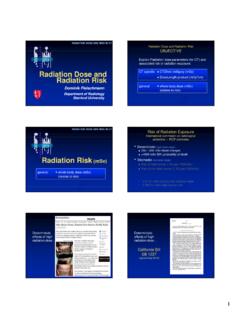Transcription of UV INDEX SOLAR - who.int
1 GLOBALSOLAR UV INDEXA Practical GuideGLOBALSOLAR UV INDEXA marked increase in the incidence of skincancers has been observed in fair-skinnedpopulations worldwide since the early1970s. This is strongly associated with personal habits in relation to sun exposureand its ultraviolet (UV) component, and thesocietal view that a tan is desirable Global SOLAR UV INDEX (UVI) describedin this document was developed in aninternational effort by WHO in collaborationwith WMO, UNEP and ICNIRP, and is a simplemeasure of the UV radiation level at theEarth s surface.
2 It serves as an importantvehicle to raise public awareness and toalert people about the need to adopt protective measures when exposed to , WHO s Global UV Project, aims toreduce the burden of disease resultingfrom exposure to UV radiation by assessingand quantifying health risks, and developingan appropriate response through guide-lines, recommendations and joint recommendation of:World Health OrganizationWorld Meteorological OrganizationUnited Nations Environment ProgrammeInternational Commission on Non-Ionizing radiation ProtectioniA Practical GuideA joint recommendation of:World Health OrganizationWorld Meteorological OrganizationUnited Nations Environment ProgrammeInternational Commission on Non-Ionizing radiation ProtectionWHO/SDE/ UV INDEXC opyright World Health Organization 2002 This document is not a formal publication of the World Health Organization (WHO), and all rights arereserved by the Organization.
3 The document may, however, be freely reviewed, abstracted, reproduced ortranslated, in part or in whole, but not for sale or for use in conjunction with commercial views expressed in documents by named authors are solely the responsibility of those Library Cataloguing-in-Publication DataGlobal SOLAR UV INDEX : A Practical joint recommendation of the World Health Organization, World Meteorological Organization, United Nations Environment Programme, and the International Commission on Non-Ionizing radiation Protection1. Ultraviolet rays adverse effects 2. Sunlight adverse effects 3. radiation monitoring instrumentation 4.
4 radiation monitoring standards 5. Reference values 6. Health education 7. Environmental exposure prevention and control 8. ManualsISBN 92 4 159007 6 (NLM classification: QT )Graphic icons designed by Pauls SlossPrinted in Geneva, SwitzerlandiiContentsPrefaceivIntroducti on1 The Global SOLAR UV INDEX An Educational Tool4 Reporting the UV INDEX The Basic Scheme6 Sun Protection Messages Creating Variety10 Educational Concepts and Their Practical Implementation12 AnnexAHealth Effects of UV radiation Exposure15 BInternet Links: Organizations Reporting the UV Index19 CThe UV Index21 DGraphic Presentation of the UV Index22 EAdditional Sun Protection Messages23 FList of Contributors25iii1 Everyone is exposed to UV radiation fromthe sun and many artificial sources used inindustry,commerce and from the sun include light, heatand UV UV region covers the wavelength range100 400 nm and is divided into threebands.
5 UVA (315 400 nm)UVB (280 315 nm)UVC (100 280 nm)As sunlight passes through theatmosphere, all UVC and approximately90% of UVB radiation are absorbed byozone, water vapour, oxygen and carbondioxide. UVA radiation is less affected bythe , the UV radiation reaching theEarth s surface is largely composed of UVAwith a small UVB marked increase in the incidence of skincancers has been observed in fair-skinnedpopulations worldwide since the early is strongly associated with personalhabits in relation to sun exposure and itsultraviolet (UV) component, and the societalview that a tan is desirable and programmes are urgentlyneeded to raise awareness of the damagingeffects of UV radiation , and to encouragechanges in lifestyle that will arrest the trendtowards more and more skin Global SOLAR UV INDEX (UVI) described inthis document is a simple measure of the UVradiation level at the Earth s surface and anindicator of the potential for skin damage.
6 It serves as an important vehicle toraise public awareness and to alert peopleabout the need to adopt protectivemeasures when exposed to UV radiation . TheUVI was developed through an internationaleffort by the World Health Organization(WHO) in collaboration with the UnitedNations Environment Programme (UNEP), theWorld Meteorological Organization (WMO),the International Commission on Non-Ionizing radiation Protection (ICNIRP) andthe German Federal Office for RadiationProtection (Bundesamt f r Strahlenschutz,BfS) (see Annex F for list of contributors).
7 Since its initial publication in 1995, severalinternational meetings of experts (LesDiablerets, 19941; Baltimore, 19962;LesDiablerets, 19973; Munich, 20004) have beenconvened with the aim to harmonize thereporting of the UVI and to improve its use asan educational tool to promote practical guide, prepared by EvaRehfuess, is based on the consensus reachedat the Munich meeting, and is intended to beused by national and local authorities and non-governmental organizations active inthe area of skin cancer prevention, as well as meteorological offices and media outletsinvolved with UVI reporting.
8 This publication can serve as an entry point for thedevelopment and implementation of anintegrated public health approach to sunprotection and skin cancer Report of the WMO meeting of experts on UVB measurements, data quality and standardization of UV indices, Les Diablerets,Switzerland, 22 25 July , World Meteorological Organization, 1995 (Global Atmosphere Watch, No. 95).2 Educating the public about the hazards of ultraviolet radiation . Summary report. International workshop, Baltimore, 26 28 August Proving Ground MD, Army Center for Health Promotion and Preventive Medicine, Report of the WMO WHO meeting of experts on standardization of UV indices and their dissemination to the public, Les Diablerets, Switzerland, 21 24 July ,World Meteorological Organization, 1997 (Global Atmosphere Watch, No.)
9 127).4 UV INDEX in practical use. Proceedings of an international , Federal Office for radiation Protection, Instituteof radiation Hygiene, in amounts of UV radiation are beneficialfor people and essential in the production ofvitamin D. UV radiation is also used to treatseveral diseases, including rickets, psoriasisand eczema. This takes place under medicalsupervision and the benefits of treatmentversus the risks of UV radiation exposure area matter of clinical human exposure to SOLAR UVradiation may result in acute and chronichealth effects on the skin, eye and immunesystem.
10 Sunburn and tanning are the bestknown acute effects of excessive UVradiation exposure; in the long term, UVradiation-induced degenerative changes incells, fibrous tissue and blood vessels lead topremature skin ageing. UV radiation can alsocause inflammatory reactions of the eye,such as effects include two major publichealth problems: skin cancers and two and three million non-melanoma skin cancers and approximately132000 melanoma skin cancers occurglobally each year. While non-melanoma skincancers can be surgically removed and arerarely lethal, malignant melanoma substan-tially contributes to mortality rates infair-skinned populations.













